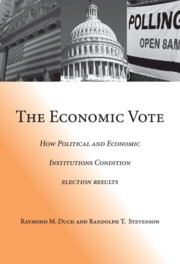Book contents
- Frontmatter
- Contents
- Preface
- 1 Introduction
- Part I Describing the Economic Vote in Western Democracies
- 2 Defining and Measuring the Economic Vote
- 3 Patterns of Retrospective Economic Voting in Western Democracies
- 4 Estimation, Measurement, and Specification
- Part II A Contextual Theory of Rational Retrospective Economic Voting: Competency Signals
- Part III A Contextual Theory of Rational Retrospective Economic Voting: Strategic Voting
- Part IV Conclusion and Summary
- Appendix A
- Appendix B
- Appendix C
- References
- Index
- Cambridge Cultural Social Studies
2 - Defining and Measuring the Economic Vote
Published online by Cambridge University Press: 06 July 2010
- Frontmatter
- Contents
- Preface
- 1 Introduction
- Part I Describing the Economic Vote in Western Democracies
- 2 Defining and Measuring the Economic Vote
- 3 Patterns of Retrospective Economic Voting in Western Democracies
- 4 Estimation, Measurement, and Specification
- Part II A Contextual Theory of Rational Retrospective Economic Voting: Competency Signals
- Part III A Contextual Theory of Rational Retrospective Economic Voting: Strategic Voting
- Part IV Conclusion and Summary
- Appendix A
- Appendix B
- Appendix C
- References
- Index
- Cambridge Cultural Social Studies
Summary
In this chapter, we explain what we mean by phrases such as “there is more economic voting in one election than in another” or “one party has a greater economic vote than another.” We begin this task with a discussion of our conceptual framework for understanding voting in general and then tackle economic voting specifically. Once our concepts are clear, we then move on to measurement issues and ultimately describe our empirical strategy for mapping the variation in economic voting across countries and over time.
A CONCEPTUAL MODEL OF VOTING
We will take the act of voting to be a discrete choice. Discrete-choice situations suppose that a decision maker chooses from a finite set of alternatives that are mutually exclusive and exhaustive. In democratic elections, vote choices can be represented by this structure. Voters are allowed to choose one party or candidate, to abstain, or to cast a blank ballot; and these alternatives are limited to those who are on the ballot at the time of voting. Given this structure, we also assume that whatever cognitive processes the individual may use to make this choice, the overall process of decision can be represented in the following way:
Each alternative in the choice set has some “value” to the individual, and this value is a function of variables that vary over alternatives, as well as variables that do not vary over alternatives but are characteristics of the individual making the choice. For example, a variable that would vary over alternatives is the voter's perception of her ideological distance from each candidate. In contrast, the voter's subjective assessment of the economy would not vary over alternatives.
[…]
- Type
- Chapter
- Information
- The Economic VoteHow Political and Economic Institutions Condition Election Results, pp. 39 - 61Publisher: Cambridge University PressPrint publication year: 2008



